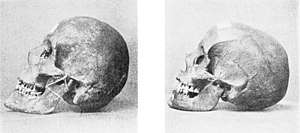Brachycephaly
Brachycephaly (derived from the Ancient Greek βραχύς, "short" and κεφαλή, "head") is the shape of a skull shorter than typical for its species. It is perceived as a desirable trait in some domesticated dog and cat breeds, notably the pug and Persian, and can be normal or abnormal in other animal species. In humans, the cephalic disorder is known as flat head syndrome, and results from premature fusion of the coronal sutures, or from external deformation. The coronal suture is the fibrous joint that unites the frontal bone with the two parietal bones of the skull. The parietal bones form the top and sides of the skull. This feature can be seen in Down syndrome.
| Brachycephaly | |
|---|---|
| Other names | Brachyceplalic |
 | |
| Brachicephaly and dolichocephaly | |
| Specialty | Medical genetics |
In anthropology, human populations have been characterized as either dolichocephalic (long headed), mesaticephalic (moderate headed), or brachycephalic (short headed). The usefulness of the cephalic index was questioned by Giuseppe Sergi, who argued that cranial morphology provided a better means to model racial ancestry.[1]
There are also cases of brachycephaly associated with plagiocephaly. Brachycephaly with plagiocephaly is positional and has become more prevalent since the "Back to Sleep" campaign. The Back to Sleep campaign began in 1994 as a way to educate parents about ways to reduce the risk for sudden infant death syndrome (SIDS). The campaign was named for its recommendation to place healthy babies on their backs to sleep. Placing babies on their backs to sleep reduces the risk for SIDS, also known as "cot death" or "crib death." This campaign has been successful in promoting infant back sleeping and other risk-reduction strategies to parents, family members, child care providers, health professionals, and all other caregivers of infants, at a cost of increasing the incidence of this deformation of the head.[2] It is considered a cosmetic problem.[3][4] Many pediatricians remain unaware of the issue and possible treatments. Treatments include regular prone repositioning of babies ("tummy time").[5]
Brachycephaly also describes a developmentally normal type of skull with a high cephalic index, such as in snub-nosed breeds of dog such as pugs, Shih Tzus, and bulldogs or cats such as the Persian, Exotic and Himalayan. The term is from Greek roots meaning "short" and "head".[6]
Diagnosis
Treatment
Brachycephaly can be corrected with a cranial remolding orthoses (helmet) which provide painless total contact over the prominent areas of the skull and leave voids over the flattened areas to provide a pathway for more symmetrical skull growth. Treatment generally takes 3–4 months, but varies depending on the infant's age and severity of the cranial asymmetry.
However studies by scientists in the Netherlands have found there was no significant difference over time between infants treated with helmets and infants left untreated. All parents of infants treated with helmets confirmed negative side effects including skin irritation and sweating.[7][8] This study focused only on patients with mild to moderate cases, the participation rate was only 21%, and there was a 73% reporting of fitting issues,[9] calling into question the validity of the study. Incorrectly fit devices cannot be expected to yield results. Additionally, independent published research that examined the effectiveness of helmet therapy conclude that as many as 95% of patients demonstrate an improvement in head shape symmetry following helmet therapy, and the American Orthotics and Prosthetics Association (AOPA) has serious concerns about the relevance and validity of this study.[10]
See also
References
- K. Killgrove (2005). "Bioarchaeology in the Roman World" (PDF). M.A. Thesis, UNC Chapel Hill. Archived from the original (PDF) on 28 March 2012. Cite journal requires
|journal=(help) - John Persing; et al. (1 July 2003). "Prevention and Management of Positional Skull Deformities in Infants". Pediatrics. 112 (1): 199–202. doi:10.1542/peds.112.1.199. PMID 12837890.
- "Plagiocephaly and brachycephaly (flat head syndrome)". NHS. 13 February 2012.
- Matthew L. Speltz; et al. (15 February 2010). "Case-Control Study of Neurodevelopment in Deformational Plagiocephaly". Pediatrics. 125 (3): e537–e542. doi:10.1542/peds.2009-0052. PMC 3392083. PMID 20156894.
Although DP is considered a purely aesthetic problem by many practitioners, several studies have challenged this view.
- Di Rocco, Federico; Ble, Valeria; Beuriat, Pierre-Aurelien; Szathmari, Alexandru; Lohkamp, Laura Nanna; Mottolese, Carmine (30 April 2019). "Prevalence and severity of positional plagiocephaly in children and adolescents". Acta Neurochirurgica. 161 (6): 1095–1098. doi:10.1007/s00701-019-03924-2.
- Chisholm, Hugh, ed. (1911). . Encyclopædia Britannica (11th ed.). Cambridge University Press.
- "Baby helmets 'have no added value', study finds". BBC News. 2 May 2014.
- Van Wijk, R. M.; Van Vlimmeren, L. A.; Groothuis-Oudshoorn, C. G. M.; Van Der Ploeg, C. P. B.; Ijzerman, M. J.; Boere-Boonekamp, M. M. (1 May 2014). "Helmet therapy in infants with positional skull deformation: randomised controlled trial". BMJ. British Medical Journal. 348: g2741. doi:10.1136/bmj.g2741. PMC 4006966. PMID 24784879.
- British Medical Journal. Retrieved 2 May 2014.
- "AOPA Response to British Medical Journal Study" (PDF).
External links
| Classification |
|
|---|